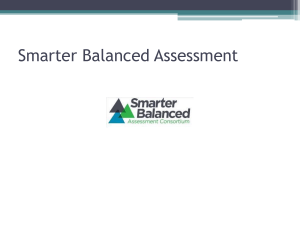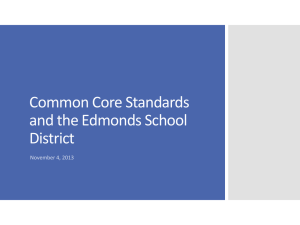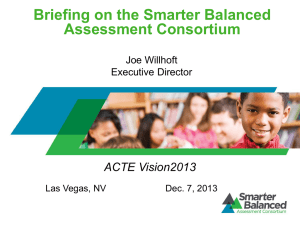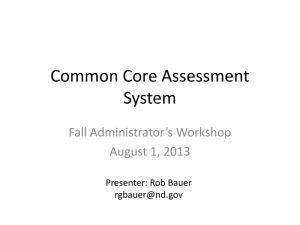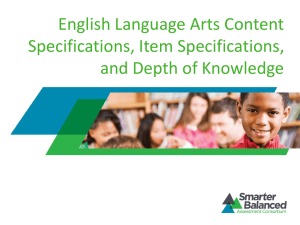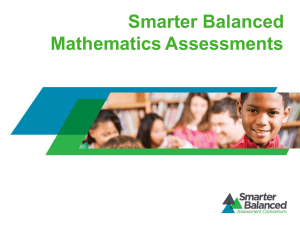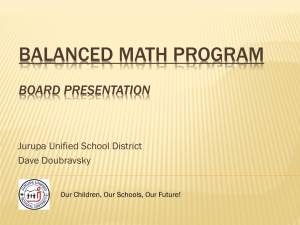From: Smarter Balanced
advertisement
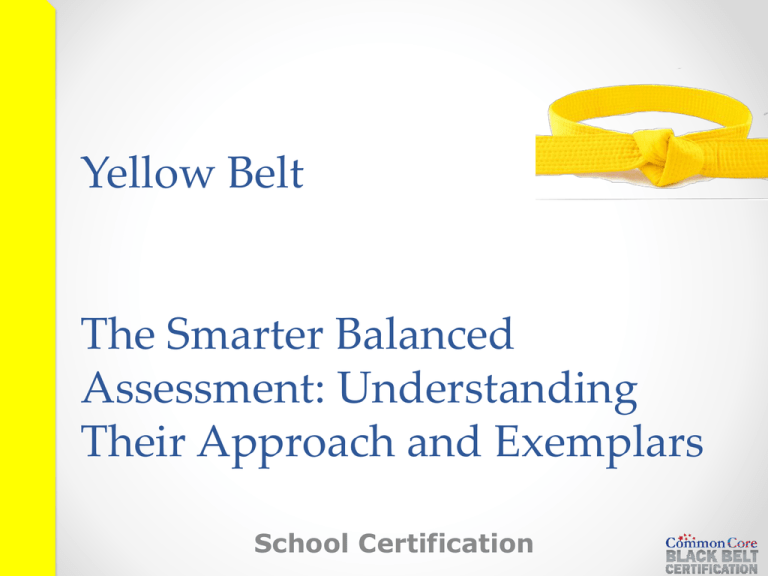
Yellow Belt The Smarter Balanced Assessment: Understanding Their Approach and Exemplars School Certification A Process of Discovery, Support and Mastery THE NATIONAL PATHWAY CONDITIONS FOR SUCCESSFUL IMPLEMENTATION Curriculum Mapping Implementation Vision + Skills + Incentives + Resources + Plan Action Plan = Sustainable Change Skills + Incentives + Resources + Plan Action Plan = Confusion Incentives + Resources + Plan Action Plan = Anxiety Resources + Plan Action Plan = Resistance Plan Action Plan = Frustration = Treadmill Vision + Vision + Skills + Vision + Skills + Incentives + Vision + Skills + Incentives + Resources Key Questions: Plan: Provides the direction to Vision: The “Why are we doing this?” to combat confusion. Resources -- "Do we have tools, time, and training to map effectively?" Vision -"Why are we doing this?" eliminate the treadmill effect. Skills: The skill sets needed to combat anxiety. Skills -- "How do we build effective maps?" Action Plan -- "Over the next three years, do we have attainable Incentives: Reasons, perks, advantages to timelines combat resistance and goals? Who will be the responsible parties for Incentives -- "How will mapping improve Resources: Tools and time needed to combat frustration. implementations, monitoring, and feedback?" teaching and learning?" Knoster, T., Villa, R., & Thousand, J. (2000) Learner Objectives • Define Summative Assessments • Discuss the current work of the national assessment consortium—The Smarter Balanced Assessment Consortium • Identify the characteristics of Smarter Balanced Assessments • Evaluate the classroom implications of Smarter Balanced Assessments Pre-Lesson Reflection • Thinking back to what was covered in the previous lessons, how have your views of assessments changed over the course? • After looking at the innovations in the PARCC assessments for your classroom, what types of changes have you made in your instruction? • What similarities and differences do you think are noticeable between PARCC and Smarter Balanced? Overview of Lesson 6 • Part I: A Close Look at Smarter Balanced Assessments o What is The Smarter Balanced Assessment Consortium? o How is Smarter Balanced different? o How are the Smarter Balanced Assessments constructed and aligned? • Part II: Stepping into the Classroom Using Smarter Balanced Assessments o Sample Assessment types o Changes in objectives, standards, and instruction Part I: A Close Look at Smarter Balanced Assessments What is Smarter Balanced? • The Smarter Balanced Assessment Consortium o Smarter Balanced is one of two Assessment Consortiums developing the Summative Assessments aligned to Common Core State Standards • 22 States aligned with PARCC • The Smarter Balanced Assessment Consortium has 24 States aligned o Summative Assessment • A test given to evaluate and document what students have learned. The term is used to distinguish such tests from formative tests, which are used primarily to diagnose what students have learned in order to plan further instruction. (ASCD Lexicon, http://www.ascd.org/Publications/Lexicon-of-Learning/S.aspx) What is Smarter Balanced? • The Smarter Balanced Assessment Consortium: o A state-led consortium working to develop a next-generation assessment system aligned to the Common Core State Standards o Work is guided by the belief that a high-quality assessment system can provide resources and tools for teachers and schools to improve instruction and help students succeed. o Federally funded initiative o Builds upon member state experiences to create high-quality, balanced, multi-state assessment ensuring comparing across states Smarter Balanced’s Purpose • Smarter Balanced sets out to: o Provide tools that will help educators both formatively assess students’ progress towards meeting the Common Core State Standards o Develop summative tools that measure student achievement of the standards at key points during each student’s development Smarter Balanced Assessment Features • Smarter Balanced asserts that unlike many current tests, Smarter Balanced tests will: o Be interim, summative, and formative assessment practices and tools o Contain a variety of item types: • Selected response • Constructed response • Extended response • Performance tasks • Technology-enabled • Technology-enhanced o Be technology-enhanced o Include adaptive testing o Have more powerful reporting o Contain a digital library of resources and tools for educators Smarter Balanced Assessments for Teachers • For Teachers, Smarter Balanced Assessments mean teachers: o Won’t be surprised by the test results at the end of the year o Will have the supports needed to help students o Will know that assessments measure the right things in the right way Smarter Balanced Assessments for Students • For Students, Smarter Balanced Assessments mean students will be: o Challenged to complete complex tasks and apply knowledge o Given information about how they are progressing toward college and career readiness o Know that their test results will be accurate regardless of ability, disability, or English proficiency How is the Smarter Balanced System Designed? From Introduction to Smarter Balanced Item and Performance Task Development PPT, smarterbalanced.org How is the Smarter Balanced System Designed? From Introduction to Smarter Balanced Item and Performance Task Development PPT, smarterbalanced.org Smarter Balanced Blueprints • According to Smarter Balanced, their blueprints detail the following: o Content (standards, indicators, claims) that is to be included for each assessed content area and grade, across various levels of the system (student, classroom, school, district, state); o Emphasis and Balance of content, generally indicated as number of items or percentage points per standard and indicator; o Item Types, sending a clear message to item developers how to measure each standard and indicator, and to teachers and students about learning expectations; and o Depth of Knowledge (DOK), indicating the complexity of item types for each standard and indicator. (Smart Balanced Assessment Consortium: Preliminary Test Blueprints, 2) Smarter Balanced vs. PARCC • Remember, the key differences between the Smarter Balanced & PARCC are: o Smarter Balanced is developing a computer adaptive assessment o Smarter Balanced’s summative assessments will adjust by presenting easier or harder questions as needed in order to measure a student’s ability o PARCC’s summative assessments will be “fixed form” o All students will receive the same test items that are statistically at the same level of difficulty Reflection • Smarter Balanced Assessments are obviously framed differently. What advantages and disadvantages do you see for having an assessment that will change based upon the students’ answers? Smarter Balanced • The Smarter Balanced Assessment Consortium o www.SmarterBalanced.org • Provides us with many other resources to help us to better understand their assessment items. • Next, we are going to look at some of their information about specific assessment question types and facts for ELA/Literacy and Math Assessment Facts for ELA/Literacy • According to Smarter Balanced’s preliminary blueprint tables ELA/Literacy Summative Assessments will: o Consist of 32-48 Computer Adaptive Test (CAT) items, dependent upon grade level o Include both selected response and constructed response o Some will be technology enhanced o ALL will be scored automatically Assessment Facts for ELA/Literacy • According to Smarter Balanced’s preliminary blueprint tables ELA/Literacy Summative Assessments will: o Will cover both literary and informational readings, with an emphasis on informational texts for 6th grade-high school o Will cover some targeted Common Core State Standards in Writing, Speaking & Listening, and Research o Will include a Performance Task (PT) that will cover Writing and Research • Combine three selected-response and constructed response items with a longer constructed-response essay o Scored for Purpose/Focus/Organization, Evidence/Elaboration, and Conventions • Some scored automatically, some by hand Assessment Facts for Math • According to Smarter Balanced’s preliminary blueprint tables— Mathematics Summative Assessments will: o Consist of 30-41 Computer Adaptive Test (CAT) items, dependent upon grade level o Include both selected response and constructed response o Some will be technology enhanced o More specificity in detail of the item types and assessment targets per grade level, rather than grade strand Assessment Facts for Math • According to Smarter Balanced’s preliminary blueprint tables— Mathematics Summative Assessments will: o Include all four of Smarter Balanced’s assessment claims • Concepts and Procedures • Problem Solving • Communicating Reasoning • Modeling and Data Analysis o Will include a Performance Task (PT) that will include stimuli and extended constructed-response item types • Focused on Problem-Solving, Communicating Reasoning, Modeling, and Data Analysis Formats and Components of Selected Response Items Lizards are fascinating creatures. There are over 3,000 known species, including monitors, skinks, geckos, chameleons, and iguanas, and they vary greatly in appearance. The largest lizard, the Komodo dragon, can grow over ten feet long, and the smallest, the Jaragua lizard, can fit on a dime. Skinks usually have smooth scales like snakes, iguanas have mohawk-like crests running down their backs, and the moloch is covered with spikes from head to tail. Lizards vary in color from shades of gray and brown to bright red or green, spotted or striped. Most have four legs but some are legless and easily confused with snakes (Hint: if it has external eardrums and eyelids it’s a lizard). Geckos can walk up walls. Chameleons not only change color but also have prehensile tails, similar to those of monkeys, that wrap around branches and their eyes can move in different directions. What is the best way to revise the highlighted sentence to match the language and style of the paragraph? A. Geckos are able to adhere to flush surfaces because setae on their footpads facilitate van der Waals forces between the setae structures and the surface. B. Geckos are awesome because they have sticky toes that allow them to climb windows like Spiderman. C. Geckos have the remarkable ability to walk up walls thanks to tiny hair-like structures on their toes that cling to smooth surfaces. D. Geckos scurry up walls like tiny dancers gliding effortlessly across a stage, their movements as natural as a well-rehearsed ballet. Distractor Analysis A. This option uses too much scientific language to fit with the rest of the paragraph. B. This option is more informal than the rest of the paragraph. C. KEY. This option uses formal, non-technical language that fits well with the rest of the paragraph. D. This option uses too much figurative language to fit with the rest of the paragraph. STIMULUS STEM OPTIONS Formats and Components of Selected Response Items Read the passage and then answer the question. The National Aeronautics and Space Administration (NASA) leads research in space exploration and aeronautics. NASA Gives Public New Internet Tool To Explore The Solar System PASADENA, Calif. – NASA is giving the public the power to journey through the solar system using a new interactive Web-based tool. The "Eyes on the Solar System" interface combines video game technology and NASA data to create an environment for users to ride along with agency spacecraft and explore the cosmos. Screen graphics and information such as planet locations and spacecraft maneuvers use actual space mission data. "This is the first time the public has been able to see the entire solar system and our missions moving together in real-time," said Jim Green, director of NASA's Planetary Science Division at the agency's Headquarters in Washington. "It demonstrates NASA's continued commitment to share our science with everyone." The virtual environment uses the Unity game engine to display models of planets, moons, asteroids, comets and spacecraft as they move through our solar system. With keyboard and mouse controls, users cruise through space to explore anything that catches their interest. A free browser plug-in, available at the site, is required to run the Web application. "You are now free to move about the solar system," said Blaine Baggett, executive manager in the Office of Communication and Education at NASA's Jet Propulsion Laboratory (JPL) in Pasadena, Calif. "See what NASA's spacecraft see – and where they are right now – all without leaving your computer." Users may experience missions in real-time, and "Eyes on the Solar System" also allows them to travel through time. The tool is populated with NASA data dating back to 1950 and projected to 2050. The playback rate can be sped up or slowed down. When NASA's Juno spacecraft launched on Aug. 5, 2011, users could look ahead to see the mission's five-year journey to Jupiter in a matter of seconds. Point of view can be switched from faraway to close-up to right "on board" spacecraft. Dozens of controls on a series of pop-up menus allow users to fully customize what they see, and video and audio tutorials explain how to use the tool's many options. Users may choose from 2-D or 3-D modes, with the latter simply requiring a pair of red-cyan glasses to see. "By basing our visualization primarily on mission data, this tool will help both NASA and the public better understand complex space science missions," said Kevin Hussey, manager of Visualization Technology Applications and Development at JPL, whose team developed "Eyes on the Solar System." "Eyes on the Solar System" is in beta release. It has been demonstrated at science conferences, in classrooms and at the 2011 South by Southwest Interactive Conference in Austin, Texas. Designers are updating "Eyes on the Solar System" to include NASA science missions launching during the coming months, including GRAIL to the moon and the Mars Science Laboratory Curiosity rover. Select the two highlighted sentences that show that NASA makes predictions about the data space missions will generate before the missions occur. KEY: “The tool is populated with NASA data dating back to 1950 and projected to 2050.” AND “When NASA's Juno spacecraft launched on Aug. 5, 2011, users could look ahead to see the mission's five-year journey to Jupiter in a matter of seconds.” In order for NASA to include projected data to 2050 and the five-year mission of a spacecraft that just launched the agency must predict data from missions before the missions occur. Distractors: The other options provide important information about the new internet tool but none of them support the inference that NASA makes predictions about the data space missions will generate before the missions occur. From: Smarter Balanced Formats and Components of Selected Response Items Read the passage and then answer the question. The National Aeronautics and Space Administration (NASA) leads research in space exploration and aeronautics. NASA Gives Public New Internet Tool To Explore The Solar System PASADENA, Calif. – NASA is giving the public the power to journey through the solar system using a new interactive Web-based tool. Users may experience missions in real-time, and "Eyes on the Solar System" also allows them to travel through time. The tool is populated with NASA data dating back to 1950 and projected to 2050. The playback rate can be sped up or slowed down. When NASA's Juno spacecraft launched on Aug. 5, 2011, users could look ahead to see the mission's five-year journey to Jupiter in a matter of seconds. Point of view can be switched from faraway to close-up to right "on board" spacecraft. Dozens of controls on a series of pop-up menus allow users to The "Eyes on the Solar System" interface combines video game technology fully customize what they see, and video and audio tutorials explain how and NASA data to create an environment for users to ride along with to use the tool's many options. Users may choose from 2-D or 3-D modes, agency spacecraft and explore the cosmos. Screen graphics and with the latter simply requiring a pair of red-cyan glasses to see. information such as planet locations and spacecraft maneuvers use actual space mission data. "By basing our visualization primarily on mission data, this tool will help both NASA and the public better understand complex space science "This is the first time the public has been able to see the entire solar system missions," said Kevin Hussey, manager of Visualization Technology and our missions moving together in real-time," said Jim Green, director Applications and Development at JPL, whose team developed "Eyes on the of NASA's Planetary Science Division at the agency's Headquarters in Solar System." Washington. "It demonstrates NASA's continued commitment to share our science with everyone." "Eyes on the Solar System" is in beta release. It has been demonstrated at science conferences, in classrooms and at the 2011 South by Southwest The virtual environment uses the Unity game engine to display models of Interactive Conference in Austin, Texas. planets, moons, asteroids, comets and spacecraft as they move through our solar system. With keyboard and mouse controls, users cruise through Designers are updating "Eyes on the Solar System" to include NASA space to explore anything that catches their interest. A free browser plug- science missions launching during the coming months, including GRAIL in, available at the site, is required to run the Web application. to the moon and the Mars Science Laboratory Curiosity rover. "You are now free to move about the solar system," said Blaine Baggett, executive manager in the Office of Communication and Education at NASA's Jet Propulsion Laboratory (JPL) in Pasadena, Calif. "See what NASA's spacecraft see – and where they are right now – all without leaving your computer." Select the two highlighted sentences that show that NASA makes predictions about the data space missions will generate before the missions occur. KEY: “The tool is populated with NASA data dating back to 1950 and projected to 2050.” AND “When NASA's Juno spacecraft launched on Aug. 5, 2011, users could look ahead to see the mission's five-year journey to Jupiter in a matter of seconds.” In order for NASA to include projected data to 2050 and the five-year mission of a spacecraft that just launched the agency must predict data from missions before the missions occur. Distractors: The other options provide important information about the new internet tool but none of them support the inference that NASA makes predictions about the data space missions will generate before the missions occur. Formats and Components of Selected Response Items • Traditional Selected Response Item Which number is both a Which number is both a factor of 100 and a multiple factor of 100 and a multiple of 5? of 5? A. 4 STEM A. 4 B. 40 Statement of B. 40 the question C. 50 C. 50 DISTRACTOR D. 500 D. 500 OPTIONS: Possible answers the students must select from • Key and Distractor Analysis A. Did not consider criteria of “multiple of 5” RATIONALE B. Did not consider criteria of “factor of 100” C. Correct D. Multiplied 100 and 5 KEY Non-Traditional Selected Response Item STIMULUS A multiplication problem is shown below. STEM 17 17××12 12 Which model(s) below could represent the solution to this Which model(s) below could represent the solution to this problem? problem? Select all that apply. Select all that apply. A. B. C. (1×1)+(1×7)+(1×2)+(2×7 ) D. E. F. (17×2)+(17×1) Non-Traditional Selected Response Item Key and Distractor Analysis: A. Does not understand how to model multiplication of two two-digit numbers using area models. B. Correct C. Did not account for the values of the digits in the tens places. D. Correct E. Did not understand that the 1 represents 10 in the multiplication problem F. Showed multiplication of 17 and (1 + 2) instead of 17 and 12 Responses to this item will receive 0–2 points, based on the following: 2 points: B, D 1 point: Either B or D 0 points: Any other combination of selections. Non-Traditional Selected Response Item For numbers 1a – 1d, state whether or not each figure has ⅖ of its whole shaded. STEM 1a. 1b. MULTIPLE 1c. PARTS 1d. OPTIONS Smarter Balanced in a nutshell… • Smarter Balanced is: o Guided by the belief that a balanced, high-quality assessment system—including formative, interim, and summative components— can improve teaching and learning • Provides information and tools for teachers and schools to help students succeed. o Timely and meaningful assessment information offers specific information about areas of performance • Teachers can follow up with targeted instruction • Students can better target their own efforts • Administrators and policymakers can more fully understand what students know and do o All leads to guiding curriculum and professional development decisions Smarter Balanced in a nutshell… • Smarter Balanced assessments make use of: o Computer adaptive technology, which is more precise and efficient than fixed-form testing. o Teachers, principals, and parents can receive results from computerized assessments in weeks, not months. o Faster results mean information can be used from optional interim assessment to differentiate instruction and better meet needs of students. Smarter Balanced in a nutshell… • Smarter Balanced assessments will: o Go beyond multiple-choice questions o Include short constructed response o Include extended constructed response o Include performance tasks that allow students to complete an in-depth project that demonstrate analytical skills and real-world problem Smarter Balanced vs. PARCC • Remember, the key differences between the Smarter Balanced & PARCC are: o Smarter Balanced is developing a computer adaptive assessment • Smarter Balanced’s summative assessments will adjust by presenting easier or harder questions as needed in order to measure a student’s ability o PARCC’s summative assessments will be “fixed form” • All students will receive the same test items that are statistically at the same level of difficulty Reflection • After hearing about Smarter Balanced and how their assessments are going to be different, what differences do you see between the design of Smarter Balanced assessments and those of your current State Standardized tests? • After reviewing some of the innovative design for these assessments, how does this impact how you design assessments for your classroom? Part II: Stepping into the Classroom using Smarter Balanced Assessments Smarter Balanced Sample Items • Utilizing Smarter Balanced’s website, http://www.SmarterBalanced.org, we can find multiple resources for sample assessment items in both ELA/Literacy and Math Cruising through… • www.smarterbalanced.org Reflection • What changes do you see in the level of questioning as demonstrated through these Smarter Balanced sample test items? • How do these changes impact the types of curriculum, instruction, and assessment we need to be utilizing in the classrooms on a daily basis? Learner Objectives • Define Summative Assessments • Discuss the current work of the national assessment consortium—The Smarter Balanced Assessment Consortium (Smarter Balanced) • Identify the characteristics of Smarter Balanced Assessments • Evaluate the classroom implications of Smarter Balanced Assessments Next Steps • Discuss with your colleagues about how these various summative assessments align with the skills and knowledge necessary in the Common Core. Knowledge Check Question: The difference between a traditional selected-response assessment question and a non-traditional selectedresponse question is: a) Students prepare a response utilizing selected pieces of text b) Students choose a correct answer from a selection of choices c) Students choose a correct answer with multiple selections from the text Knowledge Check Question: Summative assessments are used to: a) Guide instruction. b) Evaluate and document what students have learned. c) Identify what students know and understand about a new unit before starting that unit. Homework Assignments Homework Assignment • FIRST o Spend some time reviewing the sample Summative Assessments designed by Smarter Balanced. • Pay particular attention to the different types of questions: selectedresponse, constructed-response, performance task. • SECOND o Compare the assessments of Smarter Balanced with those of PARCC • What similarities do you find? • What differences? • THIRD o Select a subject area that you have just begun to cover new material or have just started a new unit. o Using the different types of questions that are being utilized by Smarter Balanced, develop an assessment for this new unit that will be aligned to the unit, but, also begin to introduce students to the types of questions they will be seeing on the Smarter Balanced Assessments. Submit your assignment to BBSchool@CommonCoreInstitute.org THANK YOU! Important for Attendance: Go to next screen and access the URL to complete the survey to be credited for attendance. Attendance & Evaluation Access the URL below and complete the short survey to record your attendance and provide feedback on this session. https://www.surveymonkey.com/s/YBLesson6 Resources • • • • • • • • Smarter Balanced, http://www.SmarterBalanced.org/ http://www.smarterbalanced.org/wordpress/wpcontent/uploads/2011/12/Smarter-Balanced-Preliminary-TestBlueprints.pdf Smarter Balanced Benefits, http://www.smarterbalanced.org/wordpress/wp-content/uploads Smarter Balanced ELA/Literacy Claims, http://www.smarterbalanced.org/wordpress/wp-content/uploads Smarter Balanced Mathematics Claims, http://www.smarterbalanced.org/wordpress/wp-content/uploads Smarter Balanced Sample Items FAQ, http://www.smarterbalanced.org/wordpress/wpcontent/uploads/2012/10/Smarter-Balanced-Sample-Items-FAQ.pdf Smarter Balanced Teachers, http://www.smarterbalanced.org/wordpress/wpcontent/uploads/2012/02/Smarter-Balanced-Teachers.pdf Theory in Action, http://www.smarterbalanced.org/wordpress/wpcontent/uploads/2012/02/Smarter-Balanced-Theory-of-Action.pdf
